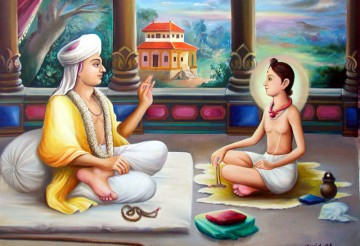The great Sages have passed the teachings and knowledge of the tradition on to disciples who in their turn became masters in an unbroken lineage since the Vedic period. The great Sage Shankaracharya organized his teaching 1200 years ago into five centers of the Himalayan Tradition. The Himalayan Yoga Meditation Tradition is one of the five centers called the Bharati lineage. Bha means “the light of knowledge,” rati means “a lover who is absorbed in it,” thus, Bharati indicates one, who as a lover of knowledge, becomes totally absorbed in its light. The methods and philosophies of the Himalayan Tradition have withstood the test of time for thousands of years and have been a vast reservoir of knowledge and experience.
The initial purpose of the tradition is to awaken the divine flame within each human being and the goal is for each student to become a master of the practice tradition in becoming conscious of yourself and coming to know his or her true Self. Self-Realization can be achieved via meditation. The teacher’s task is to selflessly help his/her disciples on the way to enlightenment. Through the transmission of a pulsation of energy, knowledge is passed down experientially.
The Himalayan Tradition combines the wisdom of Yoga-sutras of Patanjali, the contemplative insights of the Advaita Vedanta philosophy, and the intense devotion of the Shri Vidya Tantra. In the tradition, the three elements are integrally linked in a unified system. The principal tenets and practices of all known methods of meditation are included in the Himalayan Tradition and, for the most part, these systems have arisen out of it. The specific oral instructions and initiatory experiences are passed on by a long line of yoga masters and saints.
The Himalayan Yoga Meditation Tradition practice consists of several chief components.
Purification of thoughts and emotions
Prevention of internal disturbances from extraneous thoughts and sentiments arising during meditation. This is perfected by practicing the five yamas: non-violence (ahimsa), truthfulness (satya), non-stealing (asteya), abstinence from sensual indulgence (Brahmacharya), non-possessiveness (aparigraha), and the five niyamas: purity (shaucha), contentment (santosha), practices that lead to perfection of body, mind, and senses (tapas), study that leads to knowledge of the Self (svadhyaya), surrender to the ultimate reality (Ishvar pranidhana).1
Other practices to further perfect thoughts and emotions are the four brahma-viharas or right attitudes: friendliness toward the happy, compassion for the unhappy, delight in the virtuous, and indifference toward the wicked (YS.I.33). The antidotes to disturbing thoughts, prati-paksha-bhavana (YS.II.33), to ward off the thoughts (vitarkas) opposed to the yamas, niyamas, and brahma-viharas (YS.II.34) are perfected. These practices lead to chitta-pra-sadana, clarity and purification of mind, making the mind pleasant and clear, and thereby to sthiti-ni-bandhana, physical and mental stability and steadiness in life and during meditation. Further purification is accomplished by conquering the vikshepas, the nine disturbances in the path of concentration.
Mindfulness
A significant component in the practice of postures is self-awareness, a deep self-observation, in all states, of body, breath, and especially the mind.
Pranayama
Pranayama has two definitions: “control of prana” and “expansion of prana”. Prana is the ‘’primary energy’’, the entire universe is a manifestation of prana. The practice of breath regulation leads to an expansion of energetic capacity. Breath awareness and breath regulation are two of the most important components in learning and teaching yoga breathing practices and pranayama in the tradition. Breath awareness branches of into practices that lead to meditative experiences like nadi-shodhana (purification of subtle energy channels).1,2,3
Shavasana
These practices are designed to enter one’s own subtle body (sukshma sharira). The interior exercises are detailed and go far beyond pure relaxation. They can be practices at the level of annamaya kosha (body sheet), pranamaya kosha (vital sheet), or manomaya kosha (mind sheet). As prana begins to merge into its source in the manomaya kosha, the mind becomes calm, and our senses are stilled. This can lead to yoga-nidra, sleep of the yogi.1,4
Pratyahara
This is the least understood angha (component) of yoga. It means calming the mind, merging the senses in the calm mind, and calming the sense faculties. This is accomplished via breathing exercises, whereby awareness is centered in the pranamaya kosha. In fact, under a capable preceptor one feels the movement of the subtle wind of prana vayu, which is moving from one point to another point in the body.1
Japa
This is not a mere mechanical recitation of a mantra. The science of mantra is based on the sounds vibrations which are predominantly centered in the various stations of the kundalini and cannot be fully understood without initiation. The goal of japa is to bring you into supreme silence.1
Dharana
Concentration trains the mind to become one-pointed and focused and is important preparation for meditation. A proficient preceptor in the tradition is trained in various methods of concentration, including various focal points is the physical body, at the chakra points and in the tattvas (highest elements of reality) etc.3
Dhyan
All the previous described steps are preparation for meditation. Asanas prepare for a healthy properly relaxed body and allow you to sit comfortably and stably for a long period. Shavasana practices provide for a relaxed body and neuromuscular system. Meditation proper begins at the level of manomaya kosha.3
Transmission
This is a central point of the tradition. It is the ability of a teacher to pass on the energy of the tradition and teachings and to guide students in their practice.
1.Swami Rama – The Royal Path, 2.Swami Rama, Rudolph Ballentine MD, Alan Hymes MD – Science of Breath, 3.Swami Rama – Meditation and Its Practice, 4.Swami Veda Bharati – Philosophy of Hatha Yoga










Social Profiles